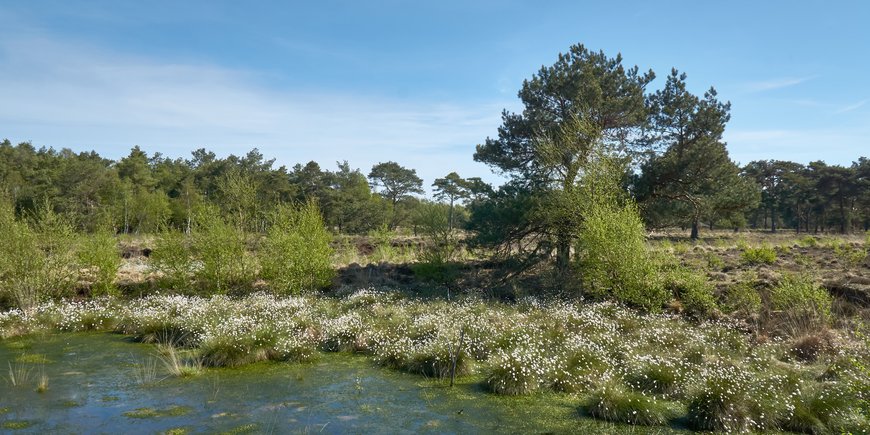In an interdisciplinary project, researchers from the Helmholtz Climate Initiative [coordinated by Nadine Mengis, GEOMAR, und Aram Kalhori, GFZ] developed a vision for Germany in 2050 that illustrates ways to achieve a carbon dioxide-neutral life and economy. In their study, which has now been published in the specialist journal Earth's Future, they look back from a fictitious future to the present day.
Germany in the year 2050. The goal of a carbon dioxide-neutral life and economy has been achieved: Greenhouse gas emissions have fallen drastically, and unavoidable emissions are counterbalanced. Changes in energy supply and new solutions in industry, transportation and traffic are key to avoiding and reducing emissions. Adaptations in agriculture and land management, such as the rewetting of peatlands and restoration of seagrass meadows, help to store carbon in natural ways. In addition, there technological approaches to removing and storing carbon dioxide (CO2) have been taken.
In this innovative study, 37 researchers from the Helmholtz Climate Initiative's “Net Zero-2050” focus look back to the present from the future. In a so-called “backcasting” approach, they bring together analyses from energy system models, findings on the circular economy in the carbon system, and evaluations of the national potential for carbon removal. The results are summarized in a retrospective of developments over the past 30 years from the year 2050. “Our vision helps to focus the discussion on the goal of our societal development,” explains Dr. Nadine Mengis, climate scientist at GEOMAR Helmholtz Centre for Ocean Research Kiel and coordinator of the study. “From our net-zero vision, we can draw conclusions for our actions today: We see that we will only reach our goal if CO2 emissions are drastically and rapidly reduced by expanding renewables. In addition, we have to remove all CO2 emissions that cannot be avoided from the atmosphere again. This is the only way to ultimately achieve a zero balance.”
The vision describes realistic options and the potential of a net-zero Germany. The authors draw three important conclusions from their consideration of the various sectors: “Rapid adaptation of the energy system to a supply from renewable sources is key to achieving net zero in Germany,” explains Dr. Mengis. But not all emissions can be completely avoided or reduced, she adds. Natural storage of carbon dioxide could only be increased to a limited extent in Germany, she said. “That’s why we had to consider technological measures for active removal and storage in geological formations in the ground.” The less emissions are cut, the more relevant these approaches become. “It is crucial to properly account for avoiding and removing emissions through natural sink enhancement; and the mitigation potential of peatland rewetting is a prime example of this”, Dr. Aram Kalhori, researcher at the German Research Centre for Geosciences (GFZ) and co-coordinator of the study, adds.
“In our vision, the need for technological measures for CO2 removal arises because, on the one hand, we did not want to assume strong changes in individual behaviour, and on the other hand, we did not want to compensate emissions outside the country,” Dr. Mengis summarizes. Implementing all the measures also requires appropriate legal and political frameworks, economic flexibility and social acceptance.
“What we need now is a political and societal debate on how we want to bring Germany to net zero, and we need to make bold decisions,” Dr. Mengis said. “However, our vision for Germany in 2050 is only one possible path. Whether our study describes a desirable net-zero future or we want to take other paths - that's something we can only decide together as a society.”
Original publication: Mengis, N., Kalhori A., et al., Net-zero CO2 Germany – A Retrospect from the Year 2050, Earth’s Future, 2022, doi.org/10.1029/2021EF002324
Further information:
Interview with Dr. Nadine Mengis, coodinator of the study
About the Helmholtz Climate Initiative
The Helmholtz Climate Initiative investigates systemic solutions for one of the greatest societal challenges of our time: climate change. Scientists from 15 Helmholtz Centres are working together to develop strategies for mitigating emissions and adapting to unavoidable climate impacts – with a focus on Germany: Cluster I “Mitigation – Net Zero 2050” is developing contributions to a roadmap that shows how Germany could reduce its carbon dioxide emissions to net zero by 2050. Cluster II “Adaptation” investigates adaptation options in areas of life affected by climate change, such as health, agriculture, energy supply or transport. The Helmholtz Climate Initiative makes scientifically based knowledge available to many areas of society and enters into dialogue with those responsible in politics, business and the media as well as the interested public.
Scientific contact:
Dr. Aram Kalhori
Section 1.4 Remote Sensing and Geoinformatics
Helmholtz Centre Potsdam
GFZ German Research Centre for Geosciences
Telegrafenberg
14473 Potsdam
Phone: +49 331 288-28847
Email: aram.kalhori@gfz-potsdam.de








![[Translate to English:] Torsten Sachs in front of a climate station on a field](/fileadmin/_processed_/3/9/csm__TorstenSachs_bearbeitet_GS_4a1365ef84.jpeg)

![[Translate to English:] left image flood at the Ahrtal: image from above, several houses are flooded; left image:: Heidi Kreibich;](/fileadmin/_processed_/4/4/csm_Bild2_9af0130e9f.png)



![[Translate to English:] Start der Vega Rakete](/fileadmin/_processed_/6/4/csm_20231201-kachel_Vega-VV23-launch_ESA-CNES-Arianespace_706716b68c.jpeg)









![[Translate to English:] Poster exhibition at the Brandenburg Hydrogen Day at the GFZ, some participants in the foreground](/fileadmin/_processed_/6/5/csm_Erster_Brandenburgischer_Wasserstofftag_GFZ_402fcec95e.jpeg)
![[Translate to English:] Group picture of the participants](/fileadmin/_processed_/9/4/csm_20231108_CAWa-Workshop-Tashkent_Gruppenbild_99ea779d8a.jpeg)

![[Translate to English:] [Translate to English:] Hörsaal](/fileadmin/_processed_/e/6/csm_H%C3%B6rsal_e21ac645fb.jpeg)


![[Translate to English:] The Delegations in the Historic Library on the Telegrafenberg. In the back there are from left to right, the Dutch Ambassador for Germany, Ronald van Roeden, the Dutch Minister for Education, Culture and Science, Robbert Dijkgraaf and the scientific director of the GFZ, Susanne Buiter.](/fileadmin/_processed_/d/b/csm_Kachel-2_9eba4b4212.jpeg)

